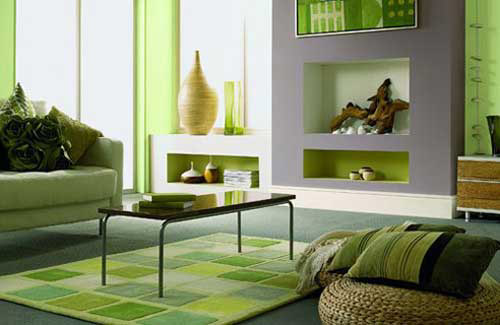Create a Focal Point
Want to bring your decorating scheme together? Heard designers banging on about focal points and wondering what it means? Here, we reveal all and show you how.
Use Contrast: Were this room to be painted white, the fireplace would be easy to overlook. However, painting it in a shade that contrasts with the colours in the rest of the room can't help but draw your eye to it. Try this trick with colour in any room to direct attention towards the best feature.
The easiest way of creating a focal point is by using one bold colour within an otherwise fairly neutral room, then by adding small details, such as accessories - cushions, vases, throws - around the room to pull the scheme together. Start off with a paint colour chart and/or fabric or wallpaper swatches to work out what you like, what suits the light in your room and what accessories are available within your budget (or already within your home) in toning shades.
Reposition your Furniture
It might be that everything you have at home is enough to create a focal point. You might not even need to redecorate. Instead, it may be that you just need to rearrange your furniture. Start by deciding what the natural focal point in the room is - a great window, a chimney breast or a view, then move your furniture so that all lines point towards it.
Use Statement Lighting
A huge arching floor lamp is always going to dominate a room and if you've got
the space, the bigger the better. You needn't spend a fortune - DIY stores sell
their own versions, as do high street stores. Place the lamp so that it hangs
over the area you want to draw attention to - a great chair, a sofa, even a
dining table.
Add Detail
In a room that has little architectural detail or interest, throw every trick at it you can and you'll get a great result. In a small or boxy space, adding fake detailing is a good way of making a focal point. Whether you choose panelling, routed and painted supawood or use mouldings, this is an ideal way to create interest in an otherwise featureless room. If you're only putting the detailing on one wall, ensure it's the one that counts.
Create Interest and Be Bold
In a boxy room or one with no discernable interest, it's up to you to create some. The cheapest way to do this is with paint. Or be bold - pattern is always going to make a featureless room more interesting, whether it's great curtains, a fabulous sofa or a wallpaper. Even in a small space, don't be afraid to choose a large scale wallpaper design - just ensure you keep the rest of the room plainly and fairly sparsely decorated. Again, knowing where to put it is all important, so experiment first to see where it works best.
Create a Display
If you want to highlight the corner of a room (or different areas of a room - and this is something you'll want to try in a big space), create make an eye-catching display with a selection of attractive pieces. Groups of three work best at different heights (this is called the 'stylist's pyramid'). Applying wall stickers to a wall in an area that you want to draw attention to is an easy and cheap way of giving a focus-free room some eye-catching detail. Experiment first before you fix the sticker permanently and don't be afraid to go for a bold, large scale design.
Knowing how to hang pictures - and, importantly, where to hang them, is an art, but one you can learn really easily. Hanging pictures in a group is a good way to create a focal point , much more so than dotting single pictures around the house. So, group together the ones you've got, lay them out on the floor and work out a pattern that works. Then hang them above a good looking sofa, across from the dining table, above the bed... anywhere you want to draw attention to.

